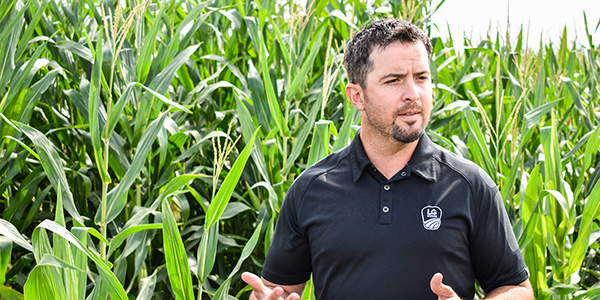AGRONOMICSUPPORT
YOU CAN TAKETO THE FIELD
Tips to Maximize Every Input Dollar
The 2022 growing season will be one of extremes, with historically high prices for corn and soybeans as well as for the inputs needed to produce them. Efficiency will be king, predicts Scott Dugan, an agronomist with LG Seeds in south-central Nebraska.
“Farmers should be looking to maximize every single input and not waste any resources, while also making sure not to leave any yield in the field,” Dugan says. He encourages farmers to lean on their agronomists and the data for this particularly important decision-making process.
“Those who have been stewards of the land and have built their soils to sustain adequate nutrient levels, can take advantage of that and not put a bunch of high inputs into this year’s crop,” he says. “But knowing the state of your soils will be essential this season.”
#1: Pinpoint needs using field testing
Soil and tissue sampling provides valuable information. “I’m not saying that you have to go out and soil sample every acre,” says Dugan. “But if you don’t have current soil samples, I would encourage farmers to collect some data, so you know what your most limiting factors are in the soil.”
Dugan also encourages farmers to be proactive with tissue testing. “Pulling a few samples before applying nitrogen or some other nutrient can guide application,” he advises. “You want something you can make actionable decisions off of,” he says.
Some might bristle at spending money on such tests, but Dugan encourages farmers to recognize that data helps add bushels and saves on inputs.
#2: Pay close attention to nutrient rates
“If we’ve addressed major issues within the soil as far as P&K, the thing that’s going to have the most influence on our yield is going to be nitrogen,” Dugan says. “Getting the timing and rate right will be critical with this moveable nutrient.”
“We really need to look at when the plant needs it at those critical stages, particularly V5 and during that rapid growth stage all the way up to tassel. But we have to spoon-feed it where possible and make sure weather events don’t wash away dollars invested in the crop,” Dugan explains.
A spoon-fed approach also keeps some money in the bank in the event the crop is devastated by drought, flooding or severe weather.
#3: Be flexible on nitrogen sources
The supply world is unpredictable and nitrogen availability could be as much of an issue as price for some producers. “Farmers may need to look to new suppliers who can meet their need or consider alternative sources,” he says. “If you were planning on liquid, maybe you switch to dry or maybe it’s a gas.”
One thing Dugan would not recommend is reducing plant populations in response to limited nitrogen supplies. He believes the industry tends to underestimate the amount of mineralization that happens within the soil. Cutting back on populations could also compromise water conservation by delaying canopy.
LG Seeds provides agronomic support and a reliable partner in the field. Bottom line, according to Dugan: “When you’re dealing with these types of input costs and commodity prices, small details equal big money.”





